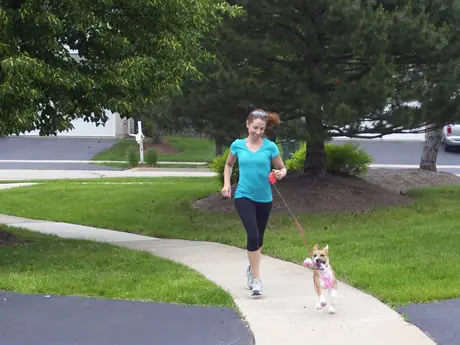Summer heat challenges even the hardiest runners. To cope, we move our workouts to the relative cool of early morning, opt for breezy garments, dial back our effort and carry extra water.
Still, we sweat like dogs.
Imagine, then, what summer running must be like for actual dogs, animals that are forever cloaked in fur coats, with high resting body temperatures (100-102 degrees) and a specialized circulatory system that warms their paws like wool socks. And panting, their main defense against heat, is much less efficient when it’s humid.
The summer heat is hairy for our furry friends at best, and those complications are compounded when we leash them up and take them running.
Of course, that’s not to say you have to run without your best friend until fall. But if you want to bring your dog along during the dog days of summer, there are five things experts want you to know.
Know Your Dog
A little knowledge about your buddy’s breed(s), medical history, age and stamina is important, because not all dogs are suited for summer running.
Those with longer, thicker or darker-colored coats, breeds with smushed faces like pugs or bulldogs, or those bred for cooler climates like huskies, typically struggle when it’s hot. Older dogs and those that snore are also more likely to be heat averse because of respiratory issues.
If you want Fido to run off a few extra pounds, remember that the fat actually makes him even hotter. Very muscular dogs also overheat faster.
“There’s so much heat coming from their muscles,” says Justine Lee, an emergency critical care veterinarian, author and CEO of VETgirl, who’s based in St. Paul, Minn. “Dogs like greyhounds, boxers or pit bulls are sprinters, not milers.”
On the other hand, pups classified in the American Kennel Club’s working, sporting and terrier groups typically make good running buddies given their natural endurance and drive.
An upright or wagging tail says he or she is happy and likely wants to keep going.
No matter your dog, get the green light from your vet before any runs, then build up Fido’s endurance slowly, as you would your own. And make sure he’s a whiz at walking on the leash before trying to run.
“Not only will this help build up your dog’s endurance, but it will also help him understand that he needs to stay by your side regardless of pace,” says Eliza Robinson, owner of Old Dominion Dog Training in Richmond, Va. “Dogs that pull against their collar can do severe damage to their spine and windpipe, so before you take off sprinting, take the time to work on loose-leash walking. It’ll make the faster pace runs more enjoyable for you both.”
Ready to Run? Make a Plan
When you’re ready for your summer run, pick a route suited to your canine companion. Stay in the shade and ideally near a lake or stream where your dog can take a cooling dip. Run early, before the heat takes hold, and be prepared to slow down or stop if your pup can’t keep up. If all four of his feet touch the ground with each stride, he can likely sustain that speed for a while. But he’ll tire quickly at full gallop, just as you do when you sprint. So if you’re training at your 5K pace, maybe do it without the K-9.
Also, look for cues that your dog is actually enjoying themselves: An upright or wagging tail says he or she is happy and likely wants to keep going.
Watch for added stressors, too, like large crowds, loud noises or busy streets, Robinson says.
“Work on helping him overcome those fears at a slow pace before taking him for a run where you’ll encounter those scenarios,” she says. “As his confidence grows and his stress fades, you can up your pace and enjoy the run.”
- 1
- of
- 2
Get ACTIVE on the Go


Couch to 5K®
The best way to get new runners off the couch and across the finish line of their first 5K.
Available for iOS | Android







Discuss This Article